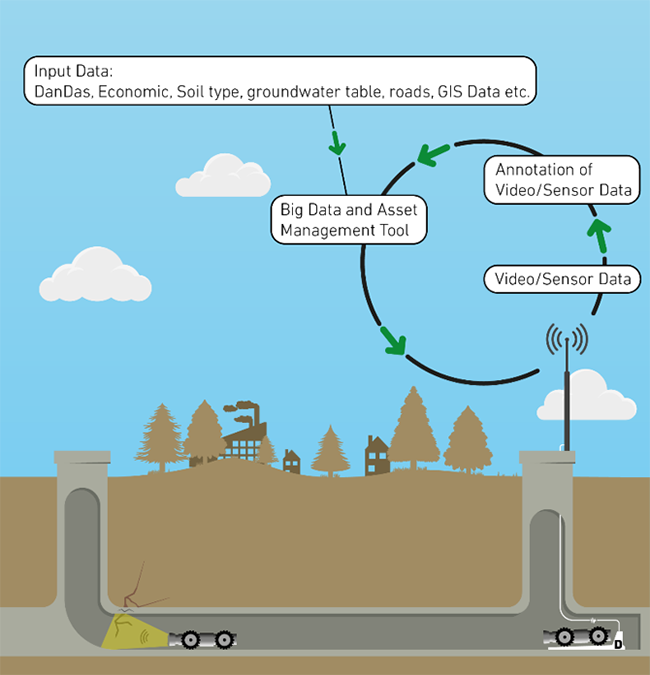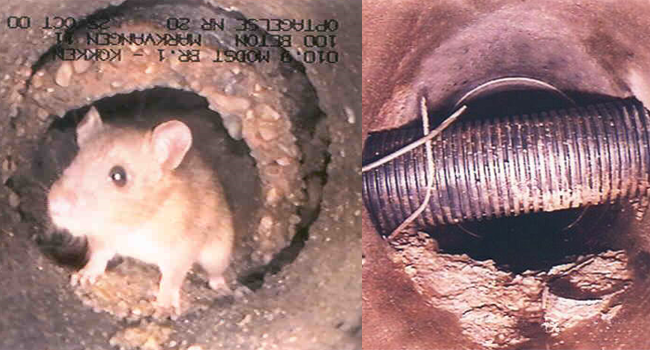At Aalborg University, Joakim Bruslund Haurum, PhD student at the Department of Architecture, Design and Media Technology, is working tirelessly on the algorithms that would decipher images from the hundreds of kilometres of Danish sewage pipes included in the research project Automated Sewer Inspection Robot (ASIR). The project aims to develop a surveillance robot that will save water companies in Denmark and throughout Europe both a lot of trouble and money. The robot autonomously drives through the sewers, inspecting the pipes using a suite of different sensors. After the robot finishes its route, the data is uploaded to a server and analysed using Joakim’s convolutional neural network computer vision algorithms. These algorithms are trained on several thousand examples from previous inspections in order to learn how to classify the different defects; a key part in deciding when to repair or replace the sewer pipes. The massive algorithm training is made possible through the use of a high-performance AI system that integrates V100 graphics processing units (GPUs). The computing platform is provided by CLAAUDIA, a research data service provider available to all researchers at Aalborg University.

‘The sewage system is an infrastructure that you don’t see because it’s underground, but when something goes wrong, it affects both health and the environment. A hole in a sewer pipe can erode the soil, and the surface may collapse so that roads, for example, crack. Until now, we’ve dug up the pipes before they fail to avoid these risks, but with our robot we will be able to leave them in longer and dig them up when we identify the need, Joakim says.
In the vast majority of cases, this will mean that the service life of the pipes can be extended by up to 10 percent. Currently, pipes are inspected manually, which is a time-consuming and costly process, and for that reason alone, many pipes are replaced automatically when they are 40-50 years old, despite the fact that a pipe without damage can easily function perfectly for up to 75 years. When Joakim and the rest of the research group are ready to bring the robot to the market, Danish water suppliers can expect annual savings in the two-digit millions of Euros.
Deep learning and massive amounts of data
In the joint office at Aalborg University, Joakim’s desktop computer is humming. The machine's GPU is powering a prototype of the algorithm that Joakim is continuously adjusting and refining. Based on several thousand examples of inspections by professional inspectors the convolutional neural networks are repeatedly shown examples of the different defects as well as normal pipes. Through this process the networks are repeatedly adjusted in order to learn the difference between the defects, and correctly classify defects in previously unseen cases. Judging from both the sound and the temperature from the machine, Joakim’s computer is perhaps right at the limit of what it has the capacity to grind through.
‘The training of the model of the robot uses enormous amounts of image data from sewer pipes collected by three major water supply companies in Denmark. For an inspection session, a small tractor with camera is sent down into the sewer tube. An inspection of 100 meters of sewerage alone can take 20-30 minutes to record. This gives us huge amounts of image data, which is of course important for the research evidence, but at the same time raises the requirements for the amount of calculations needed for the deep learning methods to function properly. The machinery that is available in the research project is fine for prototypes, but it simply cannot handle the massive amount of data the research deals with. CLAAUDIA – a strategic initiative at Aalborg University to provide digital support to research staff – offers precisely the high capacity that is essential for the algorithms that we’re basing the development of the robot on, and so it plays a crucial role,’ Joakim explains.
Taking the research to the next step
CLAAUDIA is an expert team on data management, data science, artificial intelligence, and research infrastructure as well as provider of research IT infrastructure. Through this team, Aalborg University combines infrastructure expertise, data science and data management to support researchers. This enables the researchers to communicate their needs and requirements with ease. CLAAUDIA handles the repetitive technical parts to ensure that the researchers are free to focus on research.
With Aalborg University’s AI system, Joakim and the rest of the research group can train larger, deep learning models on the datasets in parallel and fine tune several million parameters. This not only ensures the basis for the sewer robot’s accuracy, but also brings it to market faster, improving sewerage infrastructure in Denmark and abroad. Similar manual calculations would take an infinitely long time, perhaps even be impossible. CLAAUDIA also makes it possible to store and share big data, something Joakim sees obvious benefits in:
‘In general, many researchers would like to be able to upload datasets and share them publicly for other research. In principle, most researchers want to be open and transparent about research. And then it's always an advantage if research results can be replicated,’ says Joakim.
Joakim’s research group is called Visual Analysis of People. They have been talking about investing in machines with the same capacity that Aalborg University’s CLAAUDIA service offers, but it would be a huge expense in the project and no small task to apply for funding from external sources. Joakim further notes:
‘It’s important to democratise access to resources so that research is not dependent on large-scale funding to be able to use larger machines that might otherwise not be affordable. It’s really great that there is assistance at Aalborg University in the form of CLAAUDIA, both in terms of equipment and advice, also when it comes to GDPR,’ says Joakim.
CLAAUDIA supports Joakim and the ASIR research project until the project ends in 2022 when the robot will be ready to make a significant difference to water companies across Europe. In parallel, CLAAUDIA is an important partner in other research projects at Aalborg University and has the continuous capacity to support the university’s researchers in data management and consulting.
Learn more about CLAAUDIA and collaborative opportunities at www.claaudia.aau.dk
Follow ASIR, Visual Analysis of People (VAP) and Joakim Bruslund Haurum's research and development on the robot for sewer monitoring at www.envidan.dk/cases/asir-udviklingsprojekt (Danish), https://asir.create.aau.dk/, and http://www.vap.aau.dk/home/.

